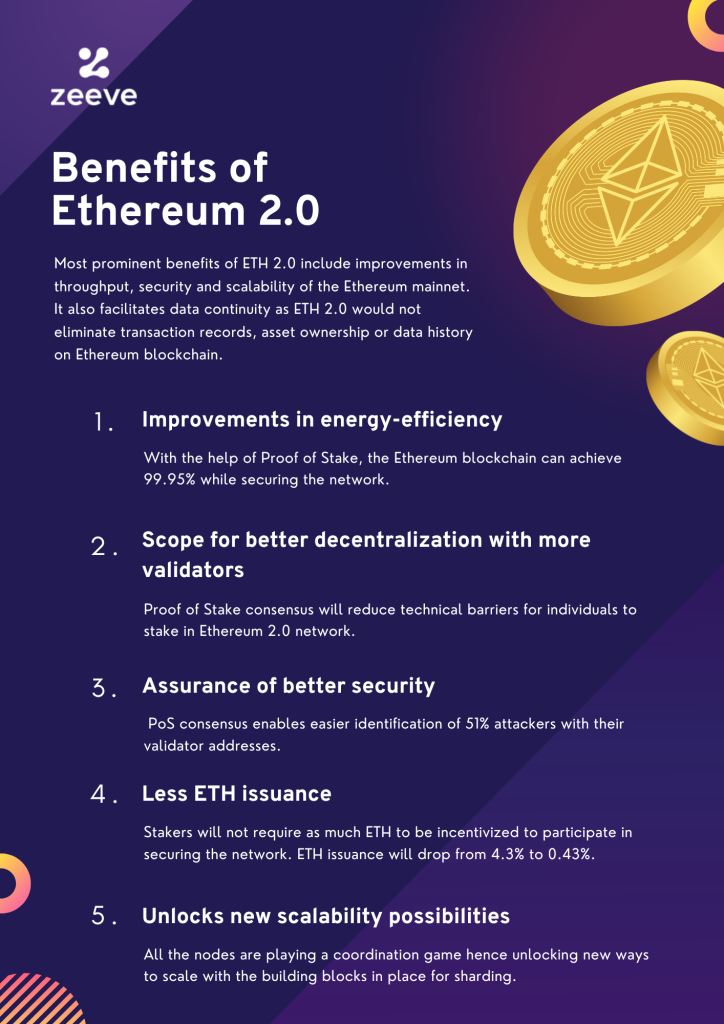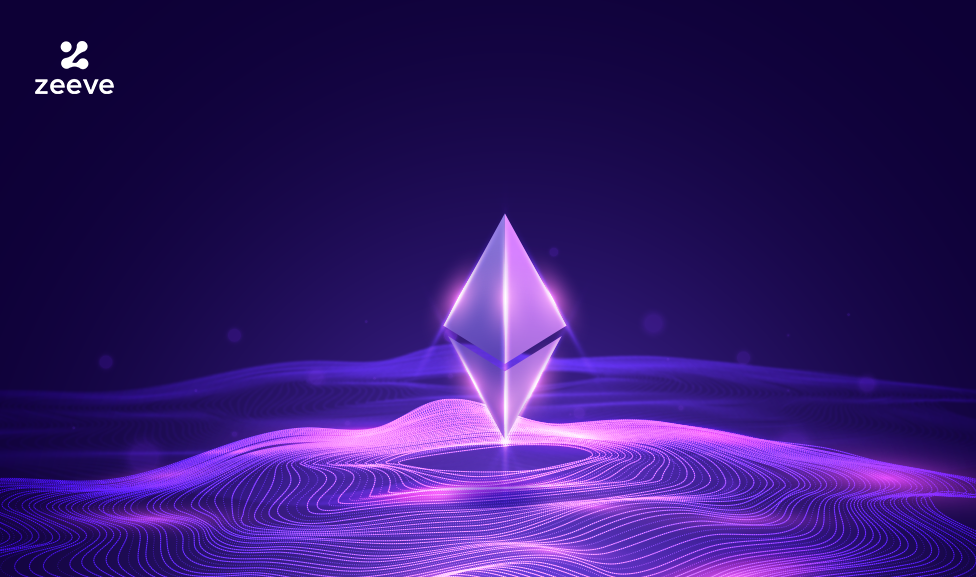Finally, the long-awaited and highly anticipated Ethereum 2.0 update was completed successfully on September 15, 2022. This consensus mechanism update marked the transition from a Proof-of-Work (PoW) protocol to a Proof-of-Stake (PoS) protocol. The blockchain network switched to a Proof-of-Stake (PoS) network seamlessly, meaning that hardware-based miners relied on Ether (ETH) to validate the network, create new blocks, and maintain the network. Ethereum ecosystem developers say that the upgrade will make the network that houses a $60 billion cryptocurrency market, lending agencies, NFT marketplaces and various other platforms more secure and scalable as well.
The upgrade of the Ethereum network aims to improve its scalability and security, with three major phases that serve as the primary thrust for it: the Beacon Chain, the Merge Chain, and the Shard Chain.
The question on everyone’s mind in the blockchain space is what is the next step? The Ethereum Foundation always has a long roadmap of milestones, and this merger is no different. The article discusses the post-merge conundrum and what this implies for Ethereum 2.0 network users going forward. It also has a list of few things that need to be fixed in order to help Ethereum 2.0 become successful.
Background before delving into The Merge
Vitalik Buterin, the founder of Ethereum, proposed a blockchain platform for Ethereum in 2013. He envisioned the day when developers could utilize decentralization to develop governance ecosystems, monetary platforms, databases, and more.
Buterin positioned Ethereum with a network that has supercomputer capabilities, but the network had trouble confirming a few hundred transactions in a reasonable time period. In fact even in the case of carrying out small transactions on the network, users were required to pay over huge transaction fees and gas fees. In general, the network hoped to become a superstar that revolutionized how the world interacted with a network.
Buterin and various other network developers and the Ethereum Foundation had knowledge of the limitations of the Ethereum blockchain. It was a known thing how some of key challenges such as slow speed, huge costs, and so on prevented institutional investors and otherwise interested parties from adopting Ethereum. Ethereum’s development team was also aware of the limitations of Ethereum’s blockchain.
Hence Buterin and ETH’s developers devised a network upgrade called Ethereum 2.0, or Eth2. Ethereum 2.0 makes fundamental changes to how Ethereum operates. Since 2020, Ethereum developers have expended a great deal of energy striving to make the network’s upgrade a reality and now since it has become a reality, we can expect the Ethereum network to become faster, more secure, and better monetarily.
What is Ethereum 2.0 – ETH 2.0?
Ethereum 2.0 is a revamp of the Ethereum blockchain that will increase the network’s speed, efficiency, and scalability, utilizing a proof-of-stake mechanism for confirming transactions through staking. It enables it to better address the bottlenecks and push up the total number of transactions Byzantine Fault Tolerance (BFT). Pseudo names used to refer to Ethereum 2.0 are Eth2 or Serenity.
The Ethereum mechanism replaces the proof of work model in cryptocurrency mining by motivating miners to perform evermore complex mathematical functions using their computer system inordinately. Cryptocurrencies rely on the electrical energy required to perform complicated mathematical operations.
Proof-of-work systems expend vast amounts of energy. Bitcoin mining, for instance, currently consumes plenty of power each year, lot more than the total sum of electrical energy consumed in Norway.
Electricity costs were equivalent to Finland’s for Ethereum, resulting in a carbon footprint comparable to that of Switzerland. Although post-merge, the ethereum network will concentrate on reducing energy consumption by 99% the merge will modify the mainnet protocol affected by the phase where PoW becomes the mainnet protocol of the proof-of-work layer of the ethereum network. The system currently involving a high-profile proof-of-stake (PoS) blockchain network will “merge” with it.
Points of Variance between Ethereum and Ethereum 2.0
The key contrast between Ethereum 2.0 and its predecessor is the method by which they distribute rewards. Ethereum employs proof of work (PoW), while Ethereum 2.0 uses proof of stake (PoS). Proof of work is a calculation process that requires considerable computing energy.
The proof of work mechanism is a labor-intensive, energy-intensive process in which miners can use complex mathematical puzzles to understand sequential data.
In the proof of stake system, cryptographic tokens are utilized to check if a transaction was accepted rather than a miner. Miners need to get the block proposed prior to its addition to the blockchain. When the majority of validators say they have seen the block, it is accepted as remuneration for them. This is how proof of stake works. PoS is a much better alternative to PoW, as it uses less electrical power to mine cryptocurrencies.
Transitioning to Ethereum 2.0
During the Ethereum Community Conference in Paris, the Ethereum blockchain’s co-founder, Vitalik Buterin mentioned how post the Merge-era, Ethereum will be complete by 55%. Merge isn’t the finale of the network but there will be “the Surge, the Verge, the Purge, and the Splurge”. Hence, for a better understanding, let’s break the transition from Ethereum to Ethereum 2.0 into a five-step, gradual process.
The Merge
The first in the five-step process is the Merge, elaborated above. Besides bringing about the drastic reduction in power consumption by 99%., it also brings about the system of rewarding validators for their work maintaining the Ethereum Network thereby turning the ETH into a deflationary asset.
The Surge
Surge implies Ethereum’s launch of mechanisms that are intended to make the system more useful by facilitating the construction of layer 2 (companion) products, such as using sharding and rollups, and thus making the network of Ethereum scalable.

In April 2023, Ethereum and its companies as a part of its foundation decided to take on Sharding, a crucial step toward enhancing the ability of the blockchain to store and retrieve data. The Ethereum Foundation explains sharding as the process of splitting a database into two parts so the network has more resources. Ethereum will use sharding in concert with layer-2 rollups by breaking down the block of what is called a layer in the following manner.
It is hoped to decrease network congestion and make transactions faster by restructuring the present fragmented database into a decentralized structure. It is made up of independent parts, or nodes, which can store and process network data without involving a central program.
It also means that a basic client can set up an Ethereum system on his own machine system or even personal devices such as computers and laptops, thereby making down the network’s dependability because of its improved decentralization.
The Ethereum Sharding
Sharding is a concept in computer science that lets applications make use of additional data by scaling them horizontally. If sharding is configured for Ethereum, each end user will only need to download a lesser file size compared to the entire transaction.
A post-Merge future has also gathered noteworthy attention at Danksharding. Ethereum developers have begun to utilize the model developed at Danksharding in order to place Ethereum more scalable.
Ethereum uses the same concept as sharding, but instead of distributing users throughout the network, it places them into groups throughout different shards. This allows the network to process bigger data volumes.
How danksharding works:
Danksharding is a sharding system that operates with a merged pool fee. It differs fundamentally from a traditional sharding system, in which there are many block proposers for different shards. The block builders choose the relevant data, transactions, and functionality that will be contained in the block.
Danksharding uses “data availability sampling,” a method by which nodes have the ability to test massive amounts of information on Ethereum by sampling only a fraction. Basically, this allows Ethereum to process more data.
A major upheaval subsequent to Ethereum’s move from proof-of-work to proof-of-stake is imminent. Adopting a modular infrastructure paradigm may incite a new set of participants: the block builder.
Under the present PoW system, Ethereum miners make decisions about block creation order. Once these miners complete their mining, they have the right to authorize which transactions are validated.
Mining helps you lock in the value of on-chain operations; this can be a helpful advantage to occupy. The value extracted by miners is named the Maximum Extractable Value (MEV).
Rollups
Essentially, rollups relay off transactions that take place outside of the regular Ethereum network and then return them to the main network to resume, update accounts, and complete the transaction.
On one end of the spectrum are Layer 2 solutions, such as State Channels that are fully secure by Ethereum security but work well for a specific set of applications. On the other end of the spectrum are side chains that run in parallel to Ethereum and are typically EVM (Ethereum Virtual Machine) compatible and can scale general purpose applications, but they do not depend on Ethereum for security and instead have their own consensus model.
Roll-ups aim to provide a solution that combines the best of both by implementing a general-purpose solution that is built on Ethereum’s security. Roll-ups create transactions that are outside the Ethereum network, but they can fill in data to the main network through Ethereum.
Rollups each have their contracts launched on the Ethereum mainnet, proceeding off-chain on a rollup-specific chain. Each rollup batches, compresses, and then transfers the transaction data to the Ethereum mainnet, where it processes the remaining transactions.
Blockchain fees and the smart contract market are both leveraged as a result of blockchain completion. In addition, it enables existing Ethereum smart contracts to be redeployed with minimal modification.
The Verge, Purge and Splurge
The final three steps post the Merge are scheduled to take place as part of Ethereum’s development roadmap in the upcoming years. Ethereum’s frontier is a major development step in the protocol’s long-term goals outlined by Buterin. Without getting too technical, the step named as the verge will involve the creation of Krypto or the verkle trees, which will enable more efficient storage of information and decrease the number of nodes used on a particular task. Hence, with the Verge, storage solutions will be optimized, node sizes will be reduced, and resultantly the Ethereum network will become more scalable.
Verkle trees are still a cutting-edge notion and are not yet as widely adopted as other cryptographic solutions. So, while Surge will be dealing with scalability and partitioning, that phase will have a direct impact on how the network handles scalability and proofs for Ethereum.
The Purge + Splurge
The Purge deletes unused historical data, which can make validation under the proof-of-stake consensus mechanism more efficient for validators. This should allow the network’s bandwidth to be used more efficiently, allowing many additional transactions to be processed on the blockchain. Buterin emphasized that Ethereum should process 100,000 transactions every second by the end of this stage.
Buterin has called the promised section the Splurge, as the activity to look for. The goal is to make Ethereum run more smoothly, and the modifications made to it in the previous configuration won’t cause problems in the system. This time, the critical task of making Ethereum more efficient will be carried out.
As in technological progress, there are bound to be hiccups in the process toward a particular goal, such as the Merge that took longer than expected. When the Splurge finally becomes available, it will be a celebratory phase for all the members of the Ethereum network.
What does Merge mean for Zeeve users?
The existing Zeeve users for Ethereum nodes or APIs will not be impacted for any of the full nodes, staking nodes or Ethereum APIs after The Merge. We have taken care of all the transition pieces so that it is seamless for all the users.





